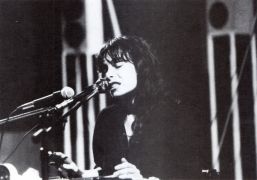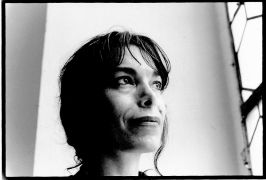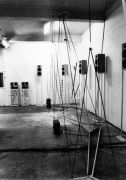"The inspiration for my work comes from the realm of myths and dreams. I like to combine ordinary objects from daily life in unexpected ways so that their symbolic nature is revealed and new levels of meaning unfold. Many of my pieces are miniature stage sets where the commonplace and the extraordinary exist, simultaneously, creating a landscape of the imagination which the viewer is invited to inhabit.“
Anna Homler
"The Dynamic Panoramaphone is a sound system that works with six tape recorders and some simple instruments that serve as a sound source. The tape recorders transform their recorded sound so that the sound richness of the sound sources can fully manifest. The tape recorders, which turn each other at a different speed, are connected to each other via mixer panels and through the audio tapes themselves. As a result, the sound is compressed and expanded in a smooth way. Further techniques include clipping, playback and scratching of the sound. There are no electronic interventions and all sounds are generated live. The sound can be heard over ten speakers, which are arranged with the appropriate tape recorders, so that a spatial effect is created."
Ad van Buuren
Anna Homler came to Plasy with Ad van Buuren from Amsterdam. She si a musician, performer, visual artist who intuitively invented her own "sleeping language“ based on the teachings of Plato and Aristotle, who believed that music restored harmony to the soul.
Anna Homler (1948) is a vocalist, and visual and performance artist based in Los Angeles. She has performed and exhibited her work in venues around the world. With a sensibility that is both ancient and post-modern, Homler sings in an improvised melodic language. Her work explores alternative means of communication and the poetics of ordinary things. She creates perceptual interventions by using language as music and objects as instruments.
Ad van Buuren (1951–2014) was a Dutch inventor and sound artist, born in Breda. He was educated at the Academie van Kunst en Vormgeving, Den Bosch (1976–1980) where he also lived and worked. The aim of van Buuren’s installations is to generate sequences of haphazard, unpredictable and chaotic sounds. Tones are evoked by artificial neural networks comprising circuits with relays. The work of these analogue circuits is programmed to resemble the activity of neurones in a human brain. The unbridled chaos that arises through it is then restrained by previously fixed parameters. Sound sources used in Ad van Buuren’s installations include forest, reed, tone generators, fans, organ sounds, ticking and clicking of relays, strings, bells, among many others.
An excerpt from their performance comprises one track of the limited-edition tape Hermit. After his death, the works of Ad van Buuren have become part of the collection of The Verbeke Foundation.




